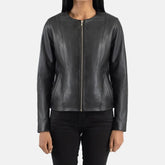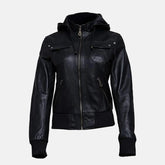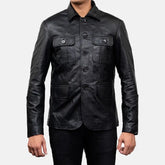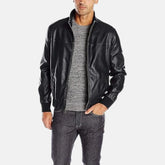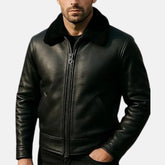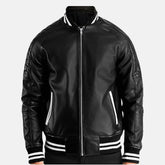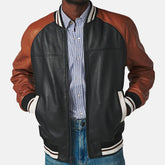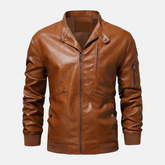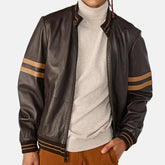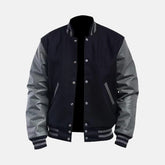-
-
Black
-
Brown
-
Dark Brown
-
Gray
Vanzero Slim Fit Leather Bomber Jacket Men - Black
- €246,95
- €246,95
- Unit price
- per
More sizes availableMaterial & ComfortIt is made from durable faux leather with a soft lining. This slim fit bomber jacket men’s style is lightweight and easy to wear daily. It keeps you comfortable for long hours without feeling heavy.Style & FitDesigned with rib-knit cuffs and a...- €246,95
- €246,95
- Unit price
- per
-
Black
-
Brown
-
Dark Brown
-
Gray
-
-
-
Black
-
Olive Brown
Avanzo Fur Collar Leather Bomber Coat - Black
- From €264,95
- From €264,95
- Unit price
- per
More sizes availableMaterial & ComfortIt is made from genuine leather. This mens leather bomber coat is strong, reliable, and made to last. The soft inner lining makes it look comfy and easy to wear all day.Style & FitThe furry collar and buckle cuffs give this leather...- From €264,95
- From €264,95
- Unit price
- per
-
Black
-
Olive Brown
-
-
-
Black Laydown Collar
-
Black Sherpa Collar
-
Brown Sherpa Collar
-
Dark Brown Faux Fur Collar
Hilfiger Rib Knit Cuffs Mens Bomber Jacket - Black Laydown Collar
- From €237,95
- From €237,95
- Unit price
- per
More sizes availableMaterial & ComfortIt is made from good quality faux leather. This leather bomber jacket mens design feels soft and easy to wear. The rib-knit cuffs keep you warm and comfortable in every season. This men’s leather bomber jacket is light yet durable, great for...- From €237,95
- From €237,95
- Unit price
- per
-
Black Laydown Collar
-
Black Sherpa Collar
-
Brown Sherpa Collar
-
Dark Brown Faux Fur Collar
-
-
-
Black
-
Brown
-
Tan Brown
Thunderbolt Leather Bomber Jacket For Men - Black
- From €242,95
- From €242,95
- Unit price
- per
More sizes availableThe Thunderbolt Leather Bomber Jacket For Men is designed from premium goatskin leather with a rich suede finish. This male leather bomber jacket is ideal for daily use and a trendy look at formal events. Soft Polyester LiningThis male leather bomber jacket comes with...- From €242,95
- From €242,95
- Unit price
- per
-
Black
-
Brown
-
Tan Brown
-
-
-
Black
-
Brown
Astral Ace Leather Bomber Jackets - Black
- From €207,95
- From €207,95
- Unit price
- per
More sizes availableThe Astral Ace Leather Bomber Jacket is made from genuine sheepskin leather for a luxurious feel. This leather bomber jacket is best for men looking for something simple and high-quality that goes well with every outfit. Quilted Fabric liningThis mens leather bomber jacket has...- From €207,95
- From €207,95
- Unit price
- per
-
Black
-
Brown
-
-
-
Black Brown
Eclipse Aviator Men's Leather Varsity Jacket - Black Brown
- From €252,95
- From €252,95
- Unit price
- per
More sizes availableThe Eclipse Aviator Men's Leather Varsity Jacket is a stylish and trendy design, made from high-quality real leather. This leather bomber jacket is best for men who want fashion with functionality. Polyester LiningThis mens leather bomber jacket comes with soft polyester lining, this jacket...- From €252,95
- From €252,95
- Unit price
- per
-
Black Brown
-
-
-
Brown
Dorian Mens Leather Bomber Jacket - Brown
- €215,95
- €215,95
- Unit price
- per
More sizes availableThe Dorian Men's Leather Bomber Jacket is made from premium cowhide leather, known for its durability and amazing quality. This mens leather bomber jacket is great for those who want both style and functionality. Quilted Viscose LiningThis mens leather bomber jacket comes with a...- €215,95
- €215,95
- Unit price
- per
-
Brown
-
-
-
Brown
-
Black
Odyssey Onyx Leather Jacket | Leather Bomber Jacket - Brown
- From €255,95
- From €255,95
- Unit price
- per
More sizes availableThe Odyssey Onyx Men’s Leather Bomber Jacket is the perfect mix of urban style and tough toughness. It was made for men who want their gear to look good and work well. Made from high-quality sheepskin leather, this leather bomber jacket will keep you warm...- From €255,95
- From €255,95
- Unit price
- per
-
Brown
-
Black
-
-
-
Black & Grey
-
Black & White
-
Black & Red
Hunter Leather Jacket | Leather Bomber Jacket - Black & Grey
- From €246,95
- From €246,95
- Unit price
- per
More sizes availableThe Hunter Leather Jacket is a classic reimagined a timeless leather bomber jacket that blends traditional varsity charm with a modern edge. Designed for men who value both function and fashion, it’s crafted to deliver warmth, durability, and effortless style season after season. Made...- From €246,95
- From €246,95
- Unit price
- per
-
Black & Grey
-
Black & White
-
Black & Red
-
-
-
Fur Lined Black
-
Shearling Lined Black
-
Shearling Lined Brown
-
Shearling Lined Cognac
Cloud Nine Shearling Lining Leather Bomber Jacket - Fur Lined Black
- €264,95
- €264,95
- Unit price
- per
More sizes availableMaterial & ComfortThis bomber jacket men’s pick is made from faux leather with cozy shearling lining, keeping you warm and stylish in colder months. The soft inner layer makes it great for long wear in chilly weather.Style & FitThe zipper closure and furry cuffs...- €264,95
- €264,95
- Unit price
- per
-
Fur Lined Black
-
Shearling Lined Black
-
Shearling Lined Brown
-
Shearling Lined Cognac
-
Subscribe to Our Newsletter
Get Promotions, new products, and sales directly to your inbox.
Learn more about our emails and our Privacy Policy.


